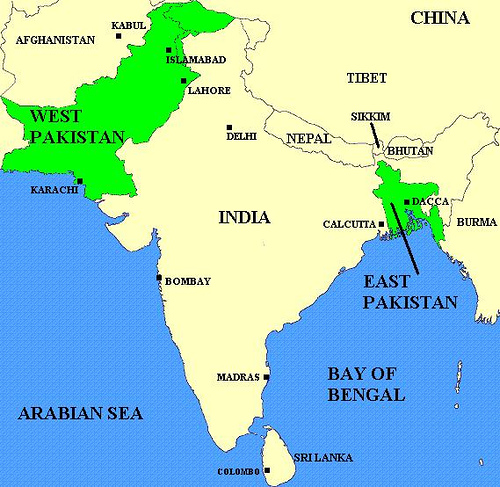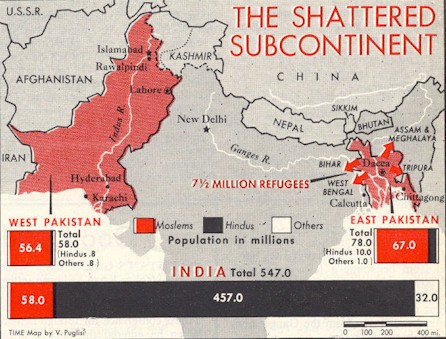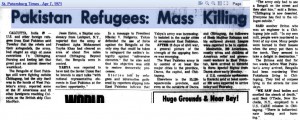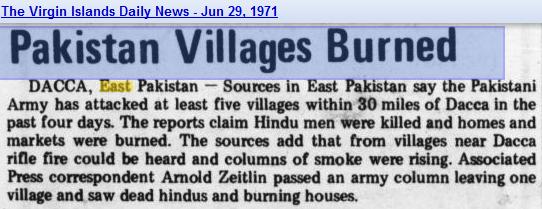It is the people of Bangladesh that has liberated this country and shaped it, no individuals or political party make no mistake about that! If need be, we will do it again! – Nasrine R. KarimThe Bangladesh Liberation War (Mukti Juddho), was a war between West Pakistan (now Pakistan) and East Pakistan (now Bangladesh), from 26 March until 16 December 1971. The war started as an insurgency in East Pakistan. Indian support for the insurgency resulted in war between India and Pakistan (the Indo-Pakistani War of 1971), during which the Indian military and East Pakistanis decisively defeated the West Pakistani forces deployed in the East. The war resulted in East Pakistan’s independence as the new nation of Bangladesh.
This page contains a summary. For a detailed timeline of the events leading to the war and aftermath of the war please see the segmentwise Timeline or the complete Time Line pages in this archive
Background:Summary of political events leading to liberation war:
# 200 years of Anti British Movement

# 1947: Independence (and partition) of India
In August 1947 the Partition of India, gave birth to a new country named Pakistan containing the Muslim-majority areas on the basis of two nation theory. These were two geographically and culturally separate areas in far east and the far west of the Indian subcontinent, separated by over a thousand miles of Indian territory. The Western zone was popularly (and for a period of time, also officially) termed West Pakistan and the Eastern zone (modern-day Bangladesh) was initially termed East Bengal and later, East Pakistan.
# 21 February 1952: Bangla Language Movement (Ekushe)
# (1952-69): Movement for Provincial Autonomy
East Pakistan, separated by the vast expanse of the Indian land mass in the middle. East and West Pakistan spoke different languages and were culturally distinct. East Pakistan accounted for the majority of ’s population, yet it was economically exploited and politically marginalized by West Pakistan. Bengalis, the people of East Pakistan, were also persecuted for speaking their native language and for being either Muslims who had converted from Hinduism or for being Hindus. Pakistan, translated as “The Land of the Pure”, was intolerant of Bengalis because they were not “pure” Muslims.
# 1969: Mass Movement & 1970′s Election: Peoples’ mandate for autonomy
The tension between East and West Pakistan began to boil over in 1970 after West Pakistan’s minimal response to the devastation wreaked by the cyclone of 1970 in East Pakistan . Nearly half a million Bengalis died as a result of the cyclone and the indifferent response by the Pakistani government. In the midst of the tension, the Pakistani military rulers decided to hold the first democratic elections in ’s history. The Awami League, representing Bengalis in East Pakistan, won the majority of seats in the National Assembly. However, the military leadership of West Pakistan refused to allow the Awami League to form a government.
The siege of East Pakistan by the Pakistani Army had begun. War was now inevitable.
(Source: the demons of 1971)
Detailed history at Profile of Bengal

The Liberation War:
The March Days: Timeline
On March 7, 1971, Sheikh Mujibur Rahman, the leader of the Awami League, gave a speech at the Dhaka Race Course that mobilized the Bengali nation for resistance. He began the speech with a call to arms:
The struggle this time is for emancipation! The struggle this time is for independence!
On March 25, 1971, the Pakistani Army launched Operation Searchlight to “eliminate” the Awami League and its supporters in East Pakistan . The goal was to “crush” the will of the Bengalis. The killing began shortly after 10 p.m. In the first 48 hours the orgy of killing had ravaged Dhaka city. The Hindu population of Dhaka took the brunt of the slaughter. Dhaka University was targeted and Hindu students were gunned down. Sheikh Mujibur Rahman was arrested shortly after declaring Bangladesh independent. The rest of the Awami League leadership went into hiding and those that survived eventually fled to . The genocide had just begun:
On February 22, 1971 the generals in West Pakistan took a decision to crush the Awami League and its supporters. It was recognized from the first that a campaign of genocide would be necessary to eradicate the threat: “Kill three million of them,” said President Yahya Khan at the February conference, “and the rest will eat out of our hands.” (Robert Payne, Massacre [1972], p. 50.) On March 25 the genocide was launched. The university in Dacca was attacked and students exterminated in their hundreds. Death squads roamed the streets of Dacca, killing some 7,000 people in a single night. It was only the beginning. “Within a week, half the population of Dacca had fled, and at least 30,000 people had been killed. Chittagong, too, had lost half its population. All over East Pakistan people were taking flight, and it was estimated that in April some thirty million people [!] were wandering helplessly across East Pakistan to escape the grasp of the military.” (Payne, Massacre, p. 48.) Ten million refugees fled to , overwhelming that country’s resources and spurring the eventual Indian military intervention. (The population of Bangladesh/East Pakistan at the outbreak of the genocide was about 75 million.)
The will of the Bengali people was not broken on the night of March 25, 1971. On the contrary, while Dhaka burned so burned the illusion of a united .The first persons to broadcast that “Sheikh Mujibur Rahman has declared the 75 million people of East Pakistan as citizens of the sovereign independent Bangla Desh.” in the evening on March 26, 1971 from Swadhin Bangla Betar Kendro in English were Ashikul Islam, a WAPDA engineer, and in Bengali, Abul Kashem Sandwipi. Later in the evening M. A. Hannan also broadcast the declaration from the telegram in a speech. (Bangladesh Observer, April 23, 1972)
The Kalurghat Bridge area was controlled by an East Bengal Regiment under Major Ziaur Rahman who revolted against the Pakistani army. Bengali soldiers were requested to gueard the station. At 7:45 pm on March 27, 1971 Major Ziaur Rahman, on request of Belal Mohammed of Shwadhin Bangla Betar Kendra, broadcast Bangladesh’s independence on behalf of Sheikh Mujibur Rahman. With the following words, the armed resistance to the army began:
This is Shadhin Bangla Betar Kendro [Free Bangla Radio]. I, Major Ziaur Rahman, at the direction of Bangobondhu Mujibur Rahman, hereby declare that the independent People’s Republic of Bangladesh has been established. At his direction, I have taken command as the temporary Head of the Republic. In the name of Sheikh Mujibur Rahman, I call upon all Bengalis to rise against the attack by the West Pakistani Army. We shall fight to the last to free our Motherland. By the grace of Allah, victory is ours. Joy Bangla.
Major Zia’s broadcast from a small radio station in Chittagong, Bangladesh was picked up by a Japanese ship in the Bay of Bengal. It was later rebroadcast by Radio and the BBC.
The genesis for crisis and catalysts for Bangladesh’s independence
(Image credit: Doc Kazi from Flickr)
Yahya Khan and the Pakistan Army planned their genocide well. Yahya Khan aimed to crush the Bengali spirit once and for all. Before the crackdown all foreign journalists were expelled from East Pakistan. Only a handful managed to evade the Pakistani Army by hiding out. These few journalists exposed to the world the planned genocide that was about to unfold.
One of the journalists that remained in Dhaka was Simon Dring. On March 30, 1971 he filed a chilling report of the massacre that took place in Dhaka on the night of the 25th of March. Dring reported that in 24 hours of killing the Pakistan Army had slaughtered as many as 7000 people in Dhaka and up to 15,000 people in all of Bangladesh. The Pakistan Army employed tanks, artillery, mortars, bazookas and machine guns against the unarmed population of Dhaka. Their targets were students, local police, intellectuals, political leaders, Awami League supporters, Hindus and ordinary citizens. They carried out their ruthless killing spree with military precision.
Simon Dring described the attack on Dhaka University as follows:
Led by American-supplied M-24 World War II tanks, one column of troops sped to Dacca University shortly after midnight. Troops took over the British council library and used it as a fire base from which to shell nearby dormitory areas.
Caught completely by surprise, some 200 students were killed in Iqbal Hall, headquarters of the militantly antigovernment students’ union, I was told. Two days later, bodies were still smoldering in burnt-out rooms, others were scattered outside, more floated in a nearby lake, an art student lay sprawled across his easel.… Army patrols also razed nearby market area. Two days later, when it was possible to get out and see all this, some of the market’s stall-owners were still lying as though asleep, their blankets pulled up over their shoulders.
The “old town” part of Dhaka city was singled out for destruction by the Pakistanis because of strong Awami League support there and because there were many Hindu residents in the area. Here is how Simon Dring described the attacks on unarmed civilians:The lead unit was followed by soldiers carrying cans of gasoline. Those who tried to escape were shot. Those who stayed were burnt alive. About 700 men, women and children died there that day between noon and 2 p.m., I was told.
…In the Hindi area of the old town, the soldiers reportedly made the people come out of their houses and shot them in groups. The area, too, was eventually razed.
The troops stayed on in force in the old city until about 11 p.m. on the night of Friday, March 26, driving around with local Bengali informers. The soldiers would fire a flare and the informer would point out the houses of Awami League supporters. The house would then be destroyed – either with direct fire from tanks or recoilless rifles or with a can of gasoline, witnesses said.
After having massacred 15,000 unarmed civilians in a single day, the Pakistani soldiers were feeling their oats. They bragged about their invincibility to Simon Dring:“These bugger men,” said one Punjabi lieutenant, “could not kill us if they tried.”
“Things are much better now,” said another officer. “Nobody can speak out or come out. If they do we will kill them – they have spoken enough – they are traitors, and we are not. We are fighting in the name of God and a united Pakistan.”
In the name of God and a united Pakistan, genocide had just begun.
St. Petersburg Times, April 7, 1971
The Pakistanis began their killing spree in the major cities of Dhaka, Chittagong and Comilla. However, as terrified Bengalis fled to the countryside, the Pakistani Army followed. Pakistan began to fly in additional troops into Bangladesh to continue the genocidal campaign. The goal was the extermination of the Bengali nation. Hindus in particular were targeted for extermination. Bengali Muslims, however, did not escape the Pakistani killing machine since Bengali Muslims were considered “tainted” by their Bengali/Hindu culture. In the face of the ongoing massacres, a guerilla army formed under the leadership of rebel Bengali military officers and organized student activists. This guerilla army, known as the Mukti Bahini in Bengali, fought a war of attrition with the Pakistani army until December, 1971. The Mukti Bahini received training and support from the Indian government as it resisted Pakistani occupation. The Pakistani army was constantly harassed by the Bangladeshi resistance. In response the Pakistani army slaughtered more Bengalis.
The genocide were carried out in three phases. The first phase was “operation searchlight” started on 25th March and carried on till early May. “Search and Destroy” was the second phase lasted from Mid May to early October which targetted to cull the insurgency by the Muktibahini. “Scorched earth” is the final phase which saw the outbreak of the India Pakistan war started on 3rd of December and ended with the surrender of Pakistani army’s Eastern command on December 16, 1971. (Read more)
The killing continued unabated throughout the summer of 1971. The army moved methodically from village to village, leaving a trail of destruction in its wake. In June the Pulitzer-prize winning journalist Sydney Schanberg filed a number of eyewitness accounts from Bangladeshi towns for the New York Times. In response, the Pakistan Army expelled him from the country on June 30, 1971.
(Link)
Schanberg described the systematic subjugation and killing of Bengalis:
Army trucks roll through the half-deserted streets of the capital of East Pakistan these days, carrying “antistate” prisoners to work-sites for hard labor. Their heads are shaved and they wear no shoes and no clothes except for shorts – all making escape difficult.
…Street designations are being changed to remove all Hindu names as well as those of Bengali Moslem nationalists as part of a campaign to stamp out Bengali culture. Shankari Bazar Road in Dacca is now Tikka Khan Road, after the lieutenant general governor of East Pakistan and whom most Bengalis call “the Butcher.”
…Since the offensive began the troops have killed countless thousands of Bengalis – foreign diplomats estimate at least 200,000 to 250,000 – many in massacres. Although the targets were Bengali Moslems and the 10 million Hindus at first, the army is now concentrating on Hindus in what foreign observers characterize as a holy war.
…Of the more than six million Bengalis who are believed to have fled to India to escape the army’s terror, at least four million are Hindus. The troops are still killing Hindus and burning and looting their villages.
When the burden of the killing became too much for the army, the Pakistanis enlisted and trained paramilitary units made up of non-Bengali Muslims and Bengali collaborators from right-wing religious parties. These paramilitary units, the al-Badr and al-Shams, worked as informers and assassins to augment the military’s gruesome task of killing Bengalis. In June 1971 Sydney Schanberg reported on the formation of these units:Throughout East Pakistan the Army is training new paramilitary home guards or simply arming “loyal” civilians, some of whom are formed into peace committees. Besides Biharis and other non-Bengali, Urdu-speaking Moslems, the recruits include the small minority of Bengali Moslems who have long supported the army – adherents of the right-wing religious parties such as the Moslem League and Jamaat-e-Islami.
Collectively known as the Razakars, the paramilitary units spread terror throughout the Bengali population. With their local knowledge, the Razakars were an invaluable tool in the Pakistani Army’s arsenal of genocide.At the end of June 1971, Sydney Schanberg visited the town of Faridpur and reported on the persecution there:
The Pakistani Army has painted big yellow “H’s” on the Hindu shops still standing in this town to identify the property of the minority eighth of the population that it has made special targets.
…The campaign against the Hindus was – and in some cases still is – systematic. Soldiers fanned through virtually every village asking where the Hindus lived. Hindu property has been confiscated and either sold or given to “loyal” citizens. Many of the beneficiaries have been Biharis, non-Bengali Moslem migrants from India, most of whom are working with the army now. The army has given weapons to large numbers of the Biharis, and it is they who have often continued the killing of Hindus in areas where the army has eased off.
…However, army commanders in the field in East Pakistan privately admit to a policy of stamping out Bengali culture, both Moslem and Hindu – but particularly Hindu.
…In Faridpur – and the situation was much the same throughout East Pakistan – there was no friction to speak of between Hindu and Moslem before the army came.
The army tried to drive a wedge between them. In April, as a public example, two Hindus were beheaded in a central square in Faridpur and their bodies were soaked in kerosene and burned.
…Still, there is no sign of a hate-Hindu psychology among the Bengali Moslems. Many have taken grave risks to shelter and defend Hindus; others express shock and horror at what is happening to the Hindus but confess that they are too frightened to help.
For his part in exposing Pakistani atrocities in Bangladesh, Sydney Schanberg was promptly expelled from Bangladesh.The West Pakistani press waged a vigorous but ultimately futile campaign to counteract newspaper and radio accounts of wholesale atrocities. One paper, the Morning News, even editorialized that the armed forces were saving East Pakistanis from eventual Hindu enslavement. The civil war was played down by the government-controlled press as a minor insurrection quickly being brought under control.
The Pakistan Army and the Razakars did not stop at simply massacring Bengalis. They also took to raping Bengali women. During nine months in 1971, over 200,000 Bengali women and girls were raped. Many were taken as sex slaves and raped multiple times by the Pakistani Army.A propaganda war between Pakistan and India ensued in which Yahya threatened war against India if that country made an attempt to seize any part of Pakistan. Yahya also asserted that Pakistan could count on its American and Chinese friends. At the same time, Pakistan tried to ease the situation in the East Wing. Belatedly, it replaced Tikka, whose military tactics had caused such havoc and human loss of life, with the more restrained Lieutenant General A.A.K. Niazi. A moderate Bengali, Abdul Malik, was installed as the civilian governor of East Pakistan. These belated gestures of appeasement did not yield results or change world opinion.
By December 1971 the genocide had decimated Bengali society. On December 3, 1971 the Indian Army formally joined the war. In 13 days the Indian Army delivered a humiliating defeat to the Pakistani Army in Bangladesh. The army that had committed mass murder against an unarmed civilian population was decisively routed in less then a fortnight.
The Pakistan army, on the verge of defeat, was determined to wipe out Bengali culture in one final act of barbarism. On December 14, 1971, the Pakistan army unleashed the paramilitary units al-Badr and al-Shams to exterminate Bengali intellectuals. The goal was to find and kill Bengali political thinkers, educators, scientists, poets, doctors, lawyers, journalists and other intellectuals. The al-Badr and al-Shams fanned out with lists of names to find and execute the core of the Bengali intellectuals. The intellectuals were arrested and taken to Rayerbazar, a marshy area in Dhaka city. There, they were gunned down with their eyes blindfolded and their hands tied behind their backs.
On December 16, 1971 the Pakistani army in Bangladesh formally surrendered. At the cost of three million dead the nation of Bangladesh was born. It was the most concentrated act of genocide of the Twentieth Century.
Birth of a flag:

The red circular disc with map of Bangladesh symbolizes blood of thousands of Bangalis killed by the Pakistanis since 1947 in the Golden Bangla. The green backdrop is, nevertheless to say, symbolizes the vitality, youthfulness, greenery and of course symbolizes also our land as the agrarian since the pre- Vedic age.
The national flag of Bangladesh was a product which first came into idea of painter Quamrul Hasan. On the 3rd March 1971, ASM Abdur Rab the then VP of Dhaka University Students´ Union had the honour of hoisting the first flag of Independent Bangladesh at the Dhaka University premise popularly known as Bat-tala.
Bangabandhu Sheikh Mujibur Rahman hoisted the flag of independent Bangladesh at his residence, 32 Dhanmondi R/A, at the outskirt of Dhaka, on the 23rd March 1971. It was an unknown Awami League worker who hoisted the first flag of independence at the historical meeting at the then Ramna Race-course on the 7th March 1971 where Sheikh Mujib tacitly called for armed struggle against Pakistani occupation Army.
No comments:
Post a Comment